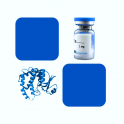
- Remove this product from my favorite's list.
- Add this product to my list of favorites.
Products
Newsletter
 |  |  |  |  |  |

Background
Interleukin 33 (IL33) is known as C9orf26, DKFZp586H0523, DVS27, NF-HEV, NFEHEV, RP11-575C20.2,and is a cytokine belonging to the IL-1 superfamily. IL-33 induces helper T cells, mast cells, eosinophils and basophils to produce type 2 cytokines. IL-33 mediates its biological effects by interacting with the receptors ST2 (aka IL1RL1) and IL-1 Receptor Accessory Protein (IL1RAP), activating intracellular molecules in the NF-κB and MAP kinase signaling pathways that drive production of type 2 cytokines (e.g. IL-5 and IL-13) from polarized Th2 cells. In vivo, IL-33 induces the expression of IL-4, IL-5, and IL-13 and leads to severe pathological changes in mucosal organs.
Source
Recombinant Human IL-33, Human IL-33 Protein, His Tag, premium grade(IL3-H52H7) is expressed from human 293 cells (HEK293). It contains AA His 109 - Thr 270 (Accession # O95760-1 ).
Predicted N-terminus: His
Human IL-33 Protein, His Tag, premium grade (IL3-H52H7), designed for preclinical stage, has the same activity and performance with GMP Human IL-33 Protein, which enables a seamless transition from preclinical development to clinical phases. Premium Grade product offer a cost efficient alternative of GMP Grade products for the early development phase when safety of raw materials is not top priority. By using Premium Grade products in early development phase, you can transition easily into clinical and commercial phase without need to revalidate the raw materials and modify manufacturing process.
Molecular Characterization
This protein carries a polyhistidine tag at the N-terminus.
The protein has a calculated MW of 20.2 kDa. The protein migrates as 25-30 kDa when calibrated against Star Ribbon Pre-stained Protein Marker under reducing (R) condition (SDS-PAGE) due to glycosylation.
Endotoxin
Less than 0.1 EU per μg by the LAL method.
Sterility
The sterility testing was performed by membrane filtration method.
Mycoplasma
Negative.
Purity
>95% as determined by SDS-PAGE.
Formulation
Lyophilized from 0.22 μm filtered solution in PBS, pH7.4 with trehalose as protectant.
Reconstitution
Please see Certificate of Analysis for specific instructions.
For best performance, we strongly recommend you to follow the reconstitution protocol provided in the CoA.
Storage
For long term storage, the product should be stored at lyophilized state at -20°C or lower.
Please avoid repeated freeze-thaw cycles.
This product is stable after storage at:
-20°C to -70°C for 12 months in lyophilized state;
-70°C for 3 months under sterile conditions after reconstitution.
Bioactivity
Please refer to product data sheet
(1) "Interleukin-9 production by type 2 innate lymphoid cells induces Paneth cell metaplasia and small intestinal remodeling
Yuan, Rayasam, Moe et al
Nat Commun (2023) 14 (1), 7963
(2) "Forsythia velutina Nakai extract: A promising therapeutic option for atopic dermatitis through multiple cell type modulation
Kwon, Kang, Kwon et al
Allergy (2023)
(3) "Inhibition of IL-33 signaling ameliorate hepatic fibrosis with decreasing MCP-1 in a mouse model of diabetes and non-alcoholic steatohepatitis; comparison for luseogliflozin, an SGLT2 inhibitor
Wakamatsu, Jojima, Hashiguchi et al
J Diabetes Complications (2023) 38 (1), 108650
Showing 1-3 of 5363 papers.
Follow us